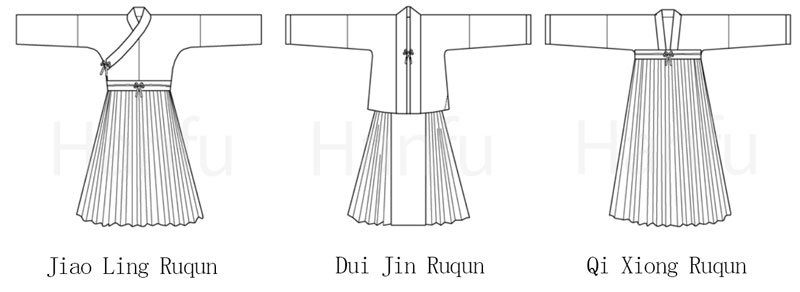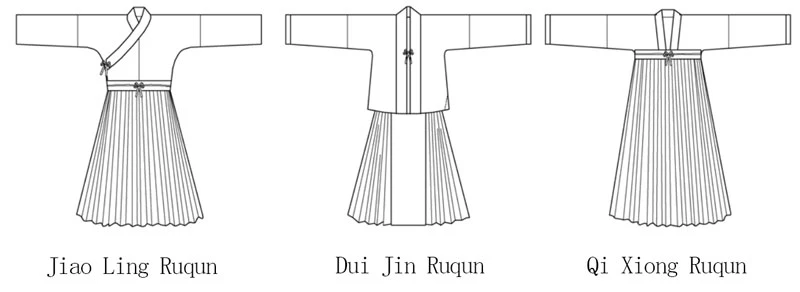This section contains Ruqun (襦裙), which can be divided into: Jiao Ling Shang Ru (交领上襦), Dui Jin Shang Ru (对襟上襦), Zhe Qun (褶裙) type A, Zhe Qun type B, Qi Xiong Shang Ru (齐胸上襦).
Size range: Jiao Ling Shang Ru, Dui Jin Shang Ru, and Qi Xiong Shang Ru (155/80A to 175/96A), Zhe Qun (155/64A to 175/80A).
Please read the introduction of the topic and how to use this guide in advance.
The Ruqun in this section should actually be called "Shan Qun (衫裙)". Ruqun is supposed to refer to the Hanfu style from the Wei and Jin dynasties, with a Yaolan (腰襕).
Introduction
Ruqun (襦裙) is one of the earliest and most basic clothing forms in the history of Chinese dress.
The Ruqun described here generally has a short upper Ru, reaching only to the waist or flush with the chest, while the Qun (skirt) is long and hangs down to the ground.
According to the different styles of the collar, can be divided into:
- Jiao Ling Ruqun(交领襦裙, cross-collar);
- Dui Jin Ruqun(对襟襦裙, lapel).
According to the height of the skirt waist, can be divided into:
- Zhong Yao Ruqun(中腰襦裙, mid-waist), the same as the Qi Yao Ruqun(齐腰襦裙);
- Gao Yao Ruqun(高腰襦裙, high-waist);
- Qi Xiong Ruqun (齐胸襦裙).
This chapter shows the cutting method of a typical Ruqun with the example of a Jiao Ling Zhong Yao Ruqun (交领中腰襦裙). This kind of Ruqun is in the form of a cross-necked, straight-sleeved Ruqun and can be worn with a pleated skirt underneath, in the form of an outer garment tucked inside the skirt, so there is no need for slits on either side of the top and the hem size is smaller.
The top of the Dui Jin Ruqun in this chapter is longer than the top of the Jiao Ling Ruqun, similar to the jacket skirt in chapter 2 (Aoqun), and the bottom is paired with a Ma Mian Qun (马面裙) or pleated skirt in the form of a tunic covering the waist of the skirt and with slits on both sides, but with the difference that it is in the form of a lapel.
Here are two ways of cutting Zhe Qun (pleated skirts), which are sewn in basically the same way, using one piece enclosed and held in place by ties, but with different ways of folding and pleating.
In ancient times, the width of the cloth was small, and six pieces of cloth 50-60 cm wide were generally used to join together to make pleated skirts, but modern cloth width is larger, so all the skirts in this guide, as well as the Ma Mian Qun in Aoqun making, have been simplified by using a larger width of fabric to sew, thus reducing the number of fabric pieces, which does not exactly match the ancient system, but makes the cutting and sewing process easier and faster, and reduces fabric seams.
The Ruqun dresses of ancient women were not very high in the waist of the skirt, but during the Sui, Tang, and Five Dynasties, there was a kind of popular Ruqun with a very high waist that was flush with the top of the chest, so it was called the "Qi Xiong Ruqun". The prototype of this Ruqun originated around the North and South Dynasties and faded out of history only after the Sui, Tang, and Five Dynasties, but it is still loved by many of Hanfu fans today.
Size chart
Jiao Ling Shang Ru (交领上襦)
Dui Jin Shang Ru (对襟上襦)
Zhe Qun (褶裙) type A
Zhe Qun type B
Qi Xiong Shang Ru (齐胸上襦)
More About Chinese Hanfu Making
Section 1: How to make Zhongyi (中衣)
Section 2: How to make Aoqun (袄裙)
Section 4: How to make Beizi (褙子)
Section 5: How to make Pan collar Aoqun (盘领袄)
Section 6: How to make Quju (曲裾)
Section 7: How to make Banbi (半臂)
Section 8: How to make Shuhe (裋褐)
Section 9: How to make Zhiduo Zhishen Daopao (直裰/直身/道袍)
Section 10: How to make Panling Pao and Lanshan (盘领袍/襕衫)
Section 11: How to make Shenyi (深衣)
Section 12: How to make Yisan (曳撒)
Section 13: How to make improved Hanfu (改良汉服)














size 155/80A What does this mean
155 is your height in cm and 80 is your chest circumference. A means a general body type. Look into the Guide of Chinese Traditional Hanfu Sewing Patterns in Hanfu Making. Everything about how to use these patterns should be there.
Hello! I was wondering why the top is cut into many pieces instead of being one piece? Why is the back panel cut in half instead of one piece?
The back seam of hanfu, and the sleeve seam, was initially caused by the insufficient width of cloth in ancient chinese times. Later, the back seam of the top was given the meaning of rigidity, fairness, and uprightness, and the seam, especially the back center seam, has been preserved as a tradition of hanfu tailoring.
If you are interested, you can check out this article: How Many Parts Does a Hanfu Upper Garment Consist Of? https://www.newhanfu.com/11368.html
How would I alter the skirt pattern to make the hem larger? All of these pattern are for the 3 metre "barrel" so what if I wanted to make the 6 metre "flower" or 9 metre "fairy"?
Assume the length of the skirt head is constant and you extend the skirt hem. This means you need to fold more pleats at the skirt head.
But I measured one of my skirts (6 M hem) and I guessed that it might have been made with a combination of several trapezoidal pieces of fabric.
Are there instructions for how to put the top together? What do the dotted lines in the detail size drawings mean? and what type of fabric would be best for the top and the skirt?
How many yards of fabric is needed to complete this?
About 500cm long * 150cm wide fabric is needed. I have made tops, roughly require 150cm*150cm of fabric.
Would 750cm long * 100cm wide work too?
Thanks for the article😍
Aaahhhhh found ittt! The reference I've been searchinggggg forrr.
Terimakasih kak atas artikelnya
It just occurred to ask this question. What is the recommended length of the ties to the qun or skirt?
The waist circumference + about 2 meters in length, specifically combined with your height.
the Qi Xiong Ruqun is definitely one of my favorites, and now I know its correct name thanks to this awesome article, thanks